Developmental phases of gross motor skills: from baby to teenager [+ play tips per phase]
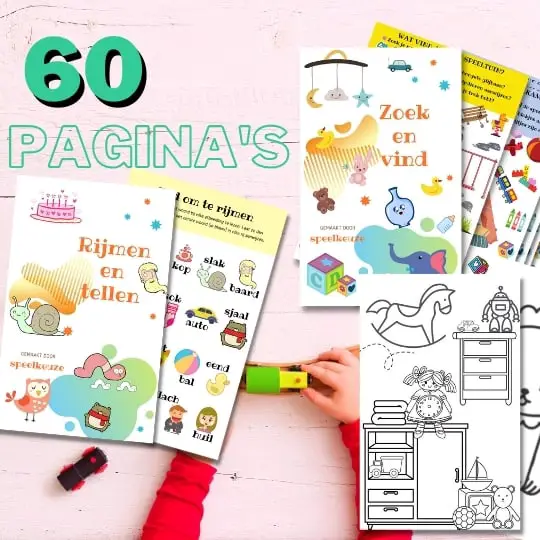
Always something to do for the holidays or rainy day?
Play Choice now has the ultimate activity book collection, with over 60 pages of fun coloring pages and educational puzzles.
From a small baby to a tough teenager; What developmental stages do our children go through when it comes to gross motor skills?
In my article I try to describe the milestones within different age groups as best as possible.
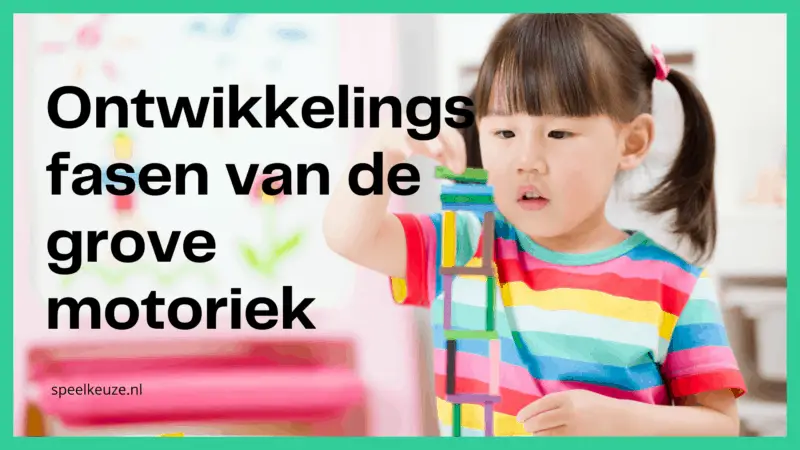
In terms of motor skills, a lot happens in childhood. I will not only discuss milestones with you, but also give you exercises and games to stimulate the development of gross motor skills in your child.
These exercises and games can all be done at home or outside with your child.
Your child will develop gross motor skills – those are the large movements a child learns as roles, to crawl, walking, running, cycling or jumping – benefit from this.
I therefore encourage you - especially in the early years - to get started with these exercises!
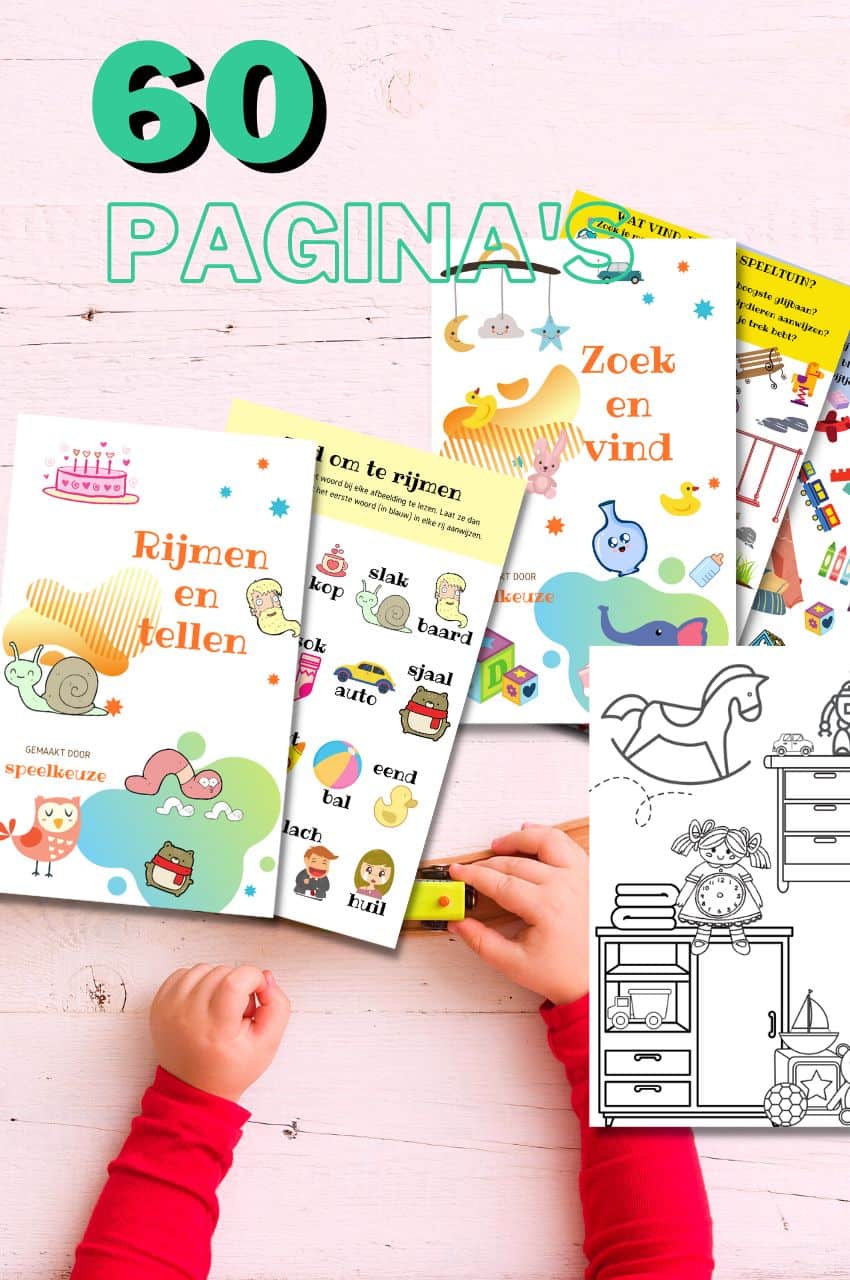
From toddler to toddler activity book collection
Educational games and coloring pages for 3 to 6 years
Your toddler and preschooler will love this e-book, along with the accompanying printables. He or she can play with it at every stage of development, together with mom and dad.
Buy at Bol.comWhat we discuss in this comprehensive post:
- 1 The difference between gross and fine motor skills
- 2 What milestones does the development of gross motor skills have in the first year of life?
- 3 What milestones does the development of gross motor skills have in the second year of life?
- 4 What milestones does the development of gross motor skills have in the third year of life?
- 5 What milestones does the development of gross motor skills have in the fourth and fifth year of life?
- 6 What milestones does the development of gross motor skills have between the sixth and ninth year of life?
- 7 What milestones does the development of gross motor skills have between the ninth and twelfth year of life?
- 8 What to do if you have doubts about motor skills?
The difference between gross and fine motor skills
We distinguish gross motor skills from fine motor skills.
Below the gross motor development This includes learning to crawl, walk, jump, but also to follow movements.
Gross motor skills are about the larger movements, but there is also such a thing as the fine motor skills; the smaller movements and also the hand motor skills required for writing, drawing and crafting.
These smaller movements are generally learned later than the gross motor movements.
Fine motor skills are usually only discussed if your child can muster sufficient attention and concentration, and that can sometimes be difficult for little ones.
That is why attention is paid to the development of fine motor skills only at primary school age.
The development of gross and fine motor skills differs per child, so don't worry if your child is a little behind.
What milestones does the development of gross motor skills have in the first year of life?
A good motor start in the baby phase is extremely important for later motor development. There is so much going on in gross motor skills this year!
The development of motor skills starts immediately after birth. The three known milestones in our baby's gross motor skills are:
- roll
- to crawl
- standing / stepping / walking
Your baby learns to roll on its side around four to five months.
A month later, the independent rolling over from stomach to back and then from back to stomach follows, the first milestone in his first year of life!
Between the ages of five and eight months, your baby begins to make forward sliding movements – on its tummy – and in the following months your baby will start to crawl.
Most babies are then between seven and eleven months. A world opens up for them and it is the next milestone in baby's first year of life.
Pay attention; There are also children who skip the entire crawling phase and start walking immediately.
Less and less baby and more and more toddlers, your child will take the first steps by hand, often between eight and fifteen months.
The age at which a child starts to walk independently can vary quite a bit, it may well be after 18 months, but also before his first birthday.
Walking is the third and perhaps most important milestone for your child.
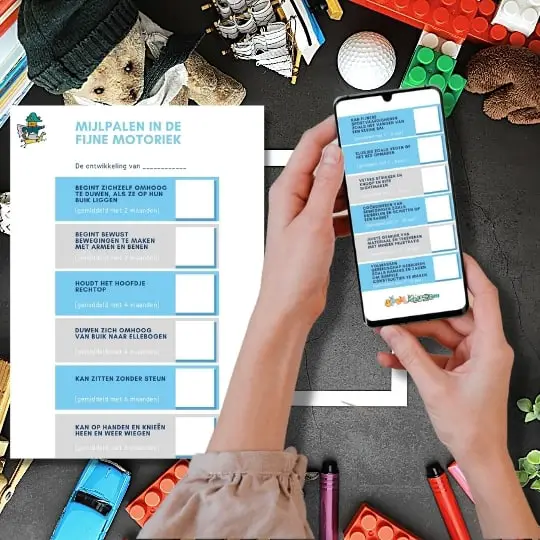
Fine motor development checklist
With this checklist you can fill in at what age your child has learned important milestones in fine motor development. Print it out and fill it in, nice to keep!
Which games are appropriate for this phase?
The rollover game
Your little one lies on his stomach on a rug or on a soft surface, put a toy next to his head, which he just can't reach. He wants to grab it and will probably roll towards the toy.
If he has trouble with it, you can help him by gently turning his lower body in the right direction.
If he is on his side, you can lift his head off the ground. You will see that his upper body turns automatically.
the bike game
Make cycling movements with his legs, these strengthen his legs and stomach. This game is good in preparation for sitting, crawling and walking.
Front to back, back to front game
If your baby can hold his head up on his own – often by four months – you can place your little one on his stomach on a rug or blanket.
Move the rug or blanket back and forth, not too quickly. This movement prepares him for crawling and develops his sense of balance.
Bubble Blowing Game
Your baby loves to reach for objects. Take your little one on your lap and blow bubbles. Good for his hand-eye coordination, because he wants to grab them!
What milestones does the development of gross motor skills have in the second year of life?
Now there is real work to be done for you as a parent or caregiver! You have to keep an eye on your little one all day long.
He walks - or still crawls - but will quickly move everywhere and want to discover everything in the house. Your little one will soon develop many more gross motor skills.
Your child learns to move better and better around the house, walks by your hand, with help or alone. Your little one may already be able to kick a ball and therefore stand on one leg for a while.
Gross motor skills are the basis for movements that we use in everyday life. Children who become skilled in exercise now will also exercise more and better at a later age.
So encourage them to exercise outside, in the playground, with a balance bike or on a tricycle, play around together at home and play with a ball.
The continuous repetition of movements and varied movement stimulates the motor development of children enormously.
From the age of 2 your child can probably already:
- going up and down a flight of stairs
- pick up something from a squat and stand up again
- kick a ball away
- catch a ball without falling te
Which games are appropriate for this phase?
Jonas game
For this game you need a blanket or towel and some stuffed animals. Lay the blanket on the floor and place a cuddly toy in the middle of the blanket.
Then have your toddler grab two ends of the blanket, just like you do. Can Jonassen manage without the cuddly toy falling to the floor?
Build a cabin
Children of this age find it fun and exciting to build their 'own' hut. Some chairs and a few sheets is often enough.
Hitting a balloon
Your toddler loves a balloon. Hit the balloon over and over again together.
It is also possible with the foot, it does not hurt!
A disadvantage is of course that the balloon can burst, do not leave your child alone with a balloon.
Skittles in the garden
With a ball and a number of plastic bottles you can make a skittle alley.
Fill the bottles with water if necessary, place the bottles next to each other on the floor and put a number of balls in a basket.
Determine the distance from which to throw. It is clear to your child when you see the place where he is allowed to throw/roll today.
Who can knock down the most pins?
This is a nice set from Melissa and Doug for this game, can be used both indoors and outdoors.
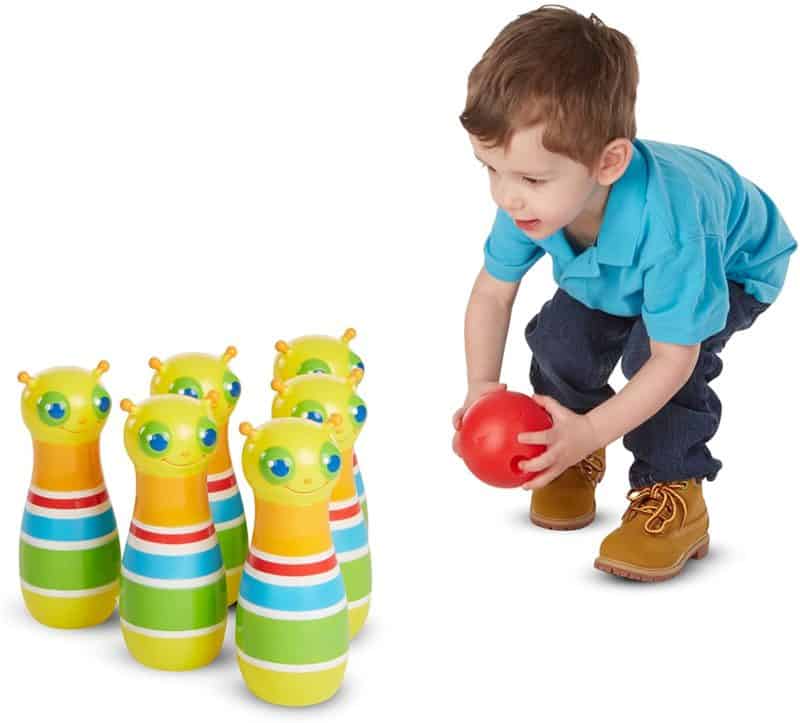
clay
Show your toddler that you can knead and squeeze clay. Make something beautiful together!
Roll into balls or roll a thick hose. It is good for fine and gross motor skills.
Look here for a large pack of clay
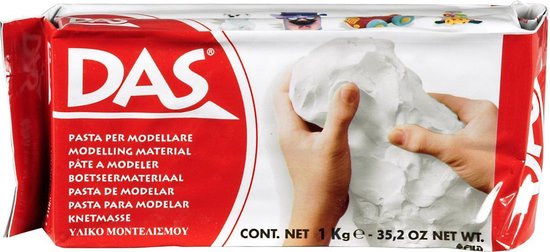
Create a track
Cut out cardboard hands and feet for this game and plot a course with it. Your child must follow the cut out hands and feet on all fours!
What milestones does the development of gross motor skills have in the third year of life?
Once your child walks quickly and climbs the stairs, many more and more difficult movements follow.
Your little toddler will feel more and more confident and move more smoothly and faster. Gross motor skills are now well developed.
Throwing a ball is no longer an effort, cycling, 'swimming', stepping, jumping, turning or hopscotch are skills that children at this age repeat over and over again.
Can your child already jump with two feet at once and walk on tiptoe?
Wash hands and brush teeth - brushing is a must! – your child can probably do it on his own now. Your little one may already be able to dress or undress himself.
However, no little one is the same and every child develops at their own pace.
From the age of 3 your toddler can:
- better run
- cycling on a tricycle
- climb the stairs neatly
- stand on one leg
- springen
- couple diving
Which games are appropriate for this phase?
Hopscotch games
Draw a small hopscotch and hop together – with tossing and picking up a pebble – with your little one, enjoying the outdoors!
move songs
Dance to your heart's content and grab strips of fabric or dance ribbons.
For example, in a song like "I Walk Like a Bear," you have to take turns walking like the animals in the song. Take a look if you don't know this happy song:
Also this music mat is a nice idea for your toddler!
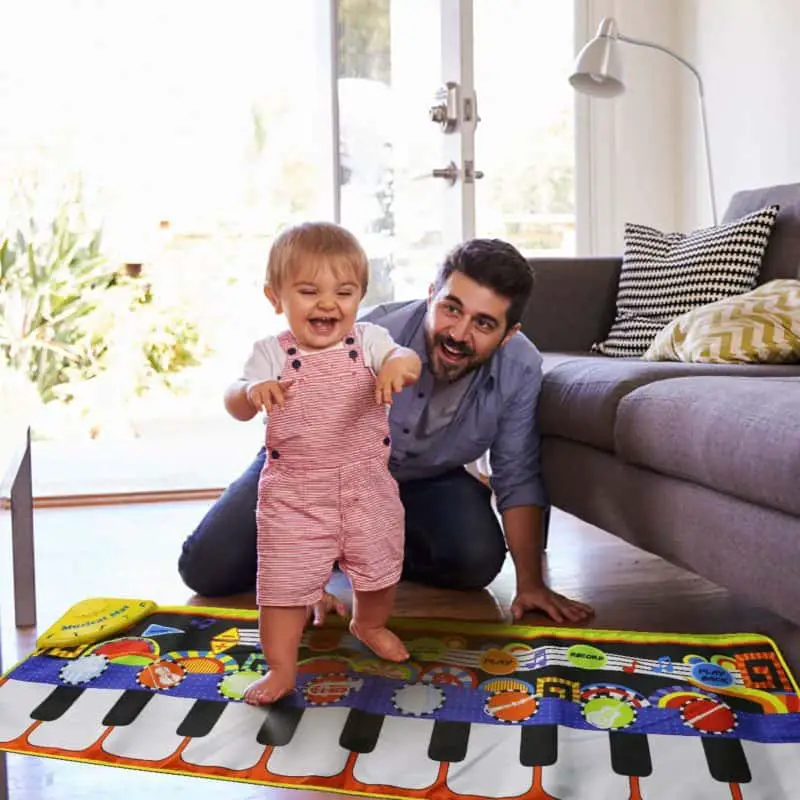
Career
Set out a course with chairs, the ottoman, a table and mats. Also let them crawl under something. A crawl tunnel is also nice.
Tricycle course
Create a course for the tricycle with some curves, which can be done in the garden or on a playground. Toddlers really enjoy cycling.
View a cool tricycle here which can be walked or cycled.
For the younger kids, you can put this unique XJD bike in three-wheel mode. But your 2-3 year old is probably using the two-wheel balance bike mode.
You can easily make a rear wheel from the two rear wheels, fold them together and you get a single wide rear wheel. What an invention and what a beautiful bike!
Compared to other tricycles, the handlebar and saddle can even be adjusted in height on the XJD tricycle.
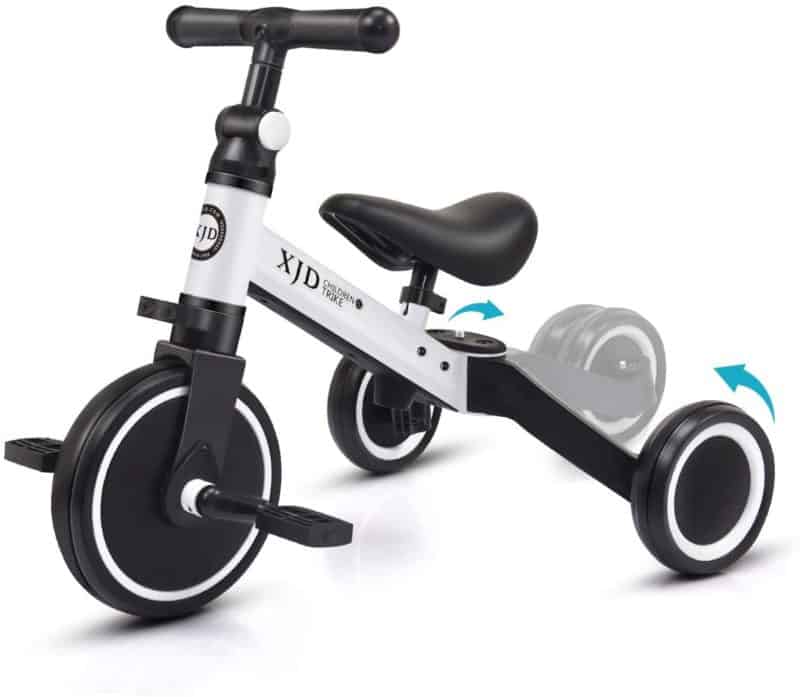
block tower
Have your toddler build a tall block tower and knock it over with a ball.
The soft foam blocks that are on sale today are great for that.
'Schipper can I sail over' game
Play the famous old Dutch game and always name a new way of moving to sail to the ferry: running, walking backwards, jumping or sliding on your buttocks. Or even with a skippy ball?
Forgot how the song went again? Take a look with Miss Mindy:
What milestones does the development of gross motor skills have in the fourth and fifth year of life?
Your child's gross motor skills continue to develop.
Playing outside and being active
Playing outside is very important for your child right now, he really needs to be able to lose his energy and often he has no patience for fine motor games.
Playing hide and seek with other children in the neighbourhood, cycling, jumping rope, stepping, running, climbing and playing tag; children aged 4 and 5 love to do that!
They can compete against each other and measure themselves against each other.
It depends on the child of course, but your child is generally still quite easily distracted, so they prefer not to sit still.
Your child is increasingly daring, swinging higher, running faster, cycling without training wheels, jumping off a diving board and so on.
Which games are appropriate for this phase?
Your child likes to play with peers; all outdoor games, such as cycling, running and romping are great for him.
Maybe it's time for a serious bike too!
Some ideas for games for children of this age:
- hold an exciting skippy ball race
- who can jump rope the longest or fastest?
- go to the playground and let them play on the climbing frame, with the swing and on the cable car
What milestones does the development of gross motor skills have between the sixth and ninth year of life?
Children from the age of six have developed their gross motor skills well.
They can also play a 'big' musical instrument from the age of six. Their limbs are now long enough for a drum, or a guitar.
After six years, your child has developed such good gross motor skills that it is now time for fine motor skills.
All the patterns that a child has developed so far are relaxed and refined every year.
Your child is now at an age where he will practice more and more to master certain motor movements even better.
Your six-year-old makes simple figures and letters, ties his own shoelaces and now clearly has a preferred hand.
A six-year-old can catch a small bouncy ball and stand on one leg a little longer. When your child is seven years old, your child can walk on a beam without too many problems. Writing is also smoother.
It is time to choose a sport or hobby for your child.
Which games are appropriate for this phase?
- set out a difficult hopscotch together
- do an old-fashioned musical chairs
- play different exercise and learning games
What milestones does the development of gross motor skills have between the ninth and twelfth year of life?
Some are already very independent at this age, others are far from ready to go shopping or cycle to school alone.
Whether your child is the oldest, the middle, or the youngest in the family can sometimes also affect this.
Your child now has quite developed muscles, enough coordination and stability, and that makes it sufficient for your child skills has to be able to move properly.
In principle, around the eleventh year, your child fully masters his motor skills.
The stamina is great, so that you can really do sports. You will see that your child is mastering more and more different sports.
Your child is also ready to play a team sport. His fine motor skills are so good that he can do precise work with ease.
Your child will probably go to school independently and maybe also to the football or gymnastics club. Around the age of nine, your child can move for a long time, balance, throw overhand with his preferred hand and sprint.
This is also the age at which – you are almost a teenager – you get a good understanding of the game.
There may be a change in your child's interests and he may sometimes enter a period of uncertainty.
Encourage continued movement at all times and limit gaming and the like.
Playing outside is still important for your child. Exercise and sports remain the right ways to gain self-confidence.
Good not only for physical development, but also for social development.
Which games are appropriate for this phase?
- a game of tennis or badminton
- a game of football, basketball or handball
- play a game of shuffleboard, table tennis, foosball or Twister
- organize an active treasure hunt
What to do if you have doubts about motor skills?
You may now have doubts about the development of your child's motor skills.
Always remember this: no child is the same and every child develops at his (or of course her) own pace.
My information about child development is based on averages. Your child may be slightly earlier or later than other children in certain motor skills.
If, after reading this article, you have any questions or doubts about the development of your child, always seek advice from an expert. They can tell you exactly what's wrong or simply reassure you!
My golden tip is: always keep moving a lot with your child or encourage him to do so!

Always something to do for the holidays or rainy day?
Play Choice now has the ultimate activity book collection, with over 60 pages of fun coloring pages and educational puzzles.
Joost Nusselder, the founder of Speelkeuze.nl is a content marketer, father and loves trying out new toys. As a child he came into contact with everything related to games when his mother started the Tinnen Soldaat in Ede. Now he and his team create helpful blog articles to help loyal readers with fun play ideas.